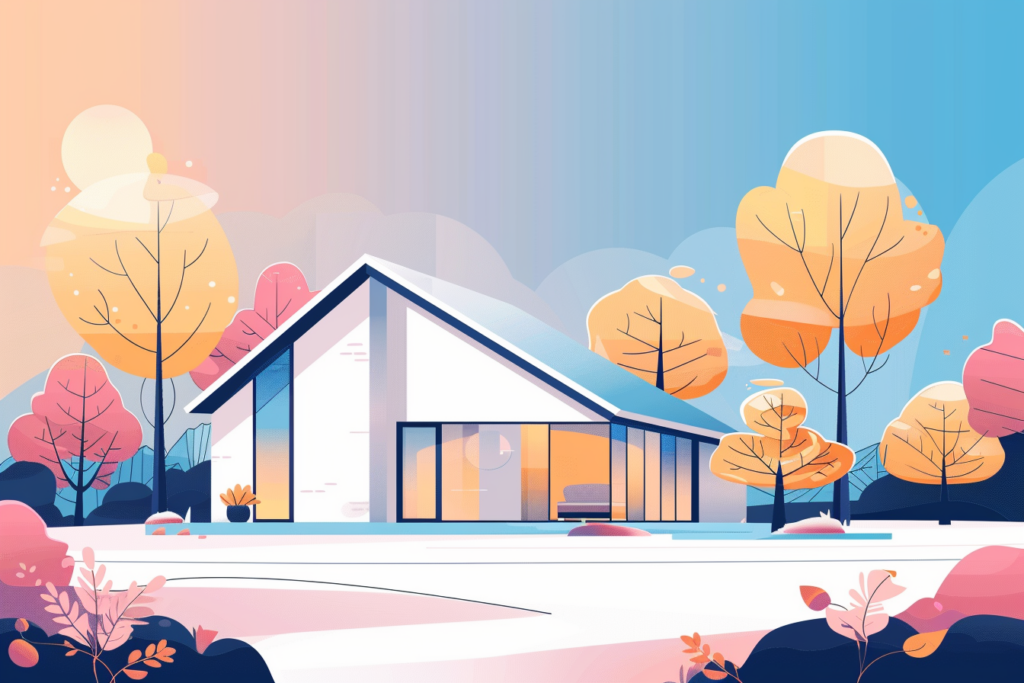When designing or renovating a building, one critical decision involves choosing the type of roof. The two primary options are flat roofs and sloped roofs, each with distinct advantages and disadvantages. Keep reading as we compare flat and sloped roofs, examining their benefits, drawbacks, and suitable scenarios for each.
Flat Roofs
A flat roof is almost level, in contrast to the many types of sloped roofs. It is not perfectly flat but has a slight pitch to allow water to drain.
Benefits of Flat Roofs
- Cost-Effective
- Lower Initial Costs: Flat roofs typically require less materials and labor to install, making them more affordable upfront than sloped roofs.
- Maintenance Savings: Flat roofs are easier and less expensive to maintain, as accessing the roof for repairs or inspections is simpler and safer.
- Additional Usable Space
- Rooftop Utilization: Flat roofs provide extra usable space for various purposes, such as solar panel installation, creating rooftop gardens, or building additional living or recreational areas.
- HVAC Placement: Flat roofs offer a convenient space for placing HVAC units, keeping them out of sight and freeing up ground space.
- Modern Aesthetic
- Sleek Design: Flat roofs contribute to a modern, minimalist architectural style that appeals to contemporary tastes.
- Versatile Look: They complement both residential and commercial buildings, fitting seamlessly into urban environments.
Drawbacks of Flat Roofs
- Water Drainage Issues
- Pooling Water: Despite a slight pitch, flat roofs can suffer from water pooling, which can lead to leaks and structural damage if they are not properly maintained.
- Drainage Systems: Effective drainage systems, such as internal drains and scuppers, are essential but can add to the initial installation costs.
- Limited Lifespan
- Material Durability: Flat roofs often have a shorter lifespan than sloped roofs, particularly if made from materials like asphalt or single-ply membranes, which are more susceptible to weather-related wear and tear.
- Frequent Repairs: Flat roofs may require more frequent repairs and maintenance due to potential water damage and UV exposure.
- Climate Considerations
- Not Ideal for Heavy Rain or Snow: Flat roofs are less suitable for regions with heavy rainfall or snowfall, as the weight of accumulated water or snow can cause structural strain and potential collapse.
Sloped Roofs
A sloped roof, sometimes called a pitched roof, has an inclined surface that allows for better water runoff. The slope can vary, creating different roof styles such as gable, hip, or mansard roofs.
Benefits of Sloped Roofs
- Effective Water Drainage
- Natural Runoff: The incline of sloped roofs ensures efficient water and snow runoff, reducing the risk of leaks and structural damage.
- Reduced Maintenance: Better drainage leads to fewer issues with water pooling, meaning less frequent maintenance and repairs.
- Increased Durability and Lifespan
- Long-Lasting Materials: Sloped roofs often use durable materials such as metal, tile, or slate, which can last significantly longer than those used for flat roofs.
- Less Weather Impact: The design minimizes the impact of weather elements, enhancing the roof’s overall durability.
- Energy Efficiency
- Insulation Benefits: Sloped roofs provide more space for insulation, improving energy efficiency by keeping homes warmer in winter and cooler in summer.
- Attic Space: The extra space created by the slope can be used for attic storage or even converted into living areas, adding value and functionality to the home.
- Aesthetic Appeal
- Traditional Look: Sloped roofs offer a classic, aesthetically pleasing appearance that complements various architectural styles.
- Versatility: They can be designed in numerous styles and finishes, enhancing the visual appeal of both residential and commercial buildings.
Drawbacks of Sloped Roofs
- Higher Initial Costs
- Material and Labor: Sloped roofs require more materials and labor to construct, resulting in higher upfront costs compared to flat roofs.
- Complexity: The complexity of designing and building a sloped roof can also increase costs, especially for intricate designs.
- Maintenance Challenges
- Accessibility: Due to the incline, performing maintenance or repairs on sloped roofs is more challenging and dangerous, often requiring professional assistance.
- Gutter Cleaning: Gutters on sloped roofs need regular cleaning to prevent any clogs, which can lead to water damage.
- Wind Vulnerability
- Wind Uplift: Sloped roofs, especially those with a steep pitch, are more susceptible to wind uplift during storms, potentially leading to damage or roof failure.
- Material Displacement: High winds can displace roofing materials such as shingles or tiles, necessitating repairs.
Suitable Scenarios for Each Roof Type
Here are a few different types of situations
Flat Roofs
- Urban Settings: Ideal for buildings in urban areas where space is at a premium, and rooftop utilization is beneficial.
- Commercial Buildings: Common in commercial construction due to the ease of installation, maintenance, and the ability to house HVAC systems on the roof.
- Modern Homes: Suitable for contemporary residential designs emphasizing a minimalist aesthetic and rooftop gardens or terraces.
Sloped Roofs
- Residential Homes: Traditional residential homes are preferred due to their classic look, durability, and efficient water drainage.
- Heavy Precipitation Areas: Ideal for regions with significant rainfall or snowfall, as the slope ensures better runoff and reduces potential water damage.
- Energy Efficiency Needs: Suitable for homes where energy efficiency is a priority, as the design allows for better insulation and additional attic space.
Sloped or Flat – The Decision is Yours
Choosing between a flat or sloped roof depends on various factors, including climate, architectural style, budget, and personal preference. Flat roofs offer cost savings, modern aesthetics, and additional usable space, making them suitable for urban settings and commercial buildings.
However, they require diligent maintenance to manage water drainage and have a shorter lifespan. Sloped roofs provide effective water runoff, increased durability, energy efficiency, and aesthetic appeal, making them ideal for residential homes and areas with heavy precipitation.
They come with higher initial costs and maintenance challenges but offer long-term benefits in durability and energy savings. Understanding these benefits and drawbacks can help you make an informed decision tailored to your specific needs and circumstances.
You might also be interested in: The Importance Of Roof Inspections And Maintenance




